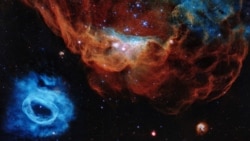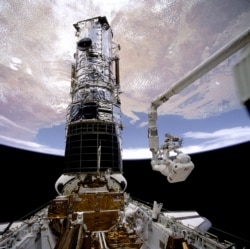NASA says it has postponed the launch of its newest space telescope because of the coronavirus crisis and technical issues.
The U.S. space agency says the launch of its James Webb Space Telescope is now planned for October 31, 2021. The launch has been delayed many times. Before the recent postponement, it had been set for March 2021.
The Webb is supposed to replace NASA’s Hubble Space Telescope, which has been in operation for 30 years.
NASA has identified the new telescope as a top science priority. The large infrared telescope has a nearly seven-meter mirror for exploring space. It is designed to look deeper into space and offer more answers about the past than any other spacecraft.
The James Webb Space Telescope was first set to fly more than 10 years ago, but has faced major development delays. Its last planned liftoff was canceled in 2018.
NASA officials said things seemed to be progressing well for the March launch date until the coronavirus hit. NASA said restrictions related to the health crisis had slowed work on the telescope by its main maker, America’s Northrop Grumman.
“Mission success is critical, but team safety is our highest priority,” NASA Associate Administrator Steve Jurczyk told The Associated Press.
Thomas Zurbuchen is with NASA's Science Mission Directorate. He said, "Webb is the world's most complex space observatory, and our top science priority, and we've worked hard to keep progress moving during the pandemic."
NASA noted that costs related to the latest postponement would not be greater than the $8.8 billion spending limit for development on the project set by Congress.
Officials say several important tests will be carried out on the telescope in the coming months. The project team will also seek to reopen and refold Webb’s massive sun shield one last time. The shield is needed to keep the infrared telescope cold in space.
NASA plans to transport the telescope next summer to its launch site in French Guiana on the northeast coast of South America. The Guiana Space Centre is a French and European Space Agency launch site.
After the launch, Webb will travel 1.5 million kilometers from Earth to orbit the sun. It will unfold the sun shield and deploy its mirror, which is designed to look for signs of light from far-away stars and galaxies.
Eric Smith is a NASA program scientist with the Webb program. He said the telescope will seek to observe “light from the first generation of galaxies that formed in the early universe after the Big Bang.” Webb is also designed to study the atmospheres of nearby exoplanets for possible signs of life.
NASA says it plans to keep the Hubble and Webb telescopes operating together for a time.
Smith noted that while Webb will be exploring new things, it will also be looking at many of the same things that Hubble did. “For me, it will be seeing old friends with completely new eyes,” Smith said.
I’m Bryan Lynn.
The Associated Press and Agence France-Presse reported on this story. Bryan Lynn adapted the reports for VOA Learning English. Ashley Thompson was the editor.
We want to hear from you. Write to us in the Comments section, and visit our Facebook page.
________________________________________________________________
Words in This Story
priority – n. something that is more important than other things and that needs to be done first
infrared – n. technical: producing or using rays of light that cannot be seen and that are longer than rays that produce red light
mirror – n. a piece of glass with metallic material on one side that produces an image of anything in front of it
pandemic – n. an occurrence in which a disease spreads very quickly and affects a large number of people
shield – n. an object used to protect something
refold – v. a process in which the sides of something are folded on top of each other to make it smaller
site – n. place where something happens
galaxy – n. a large group of stars from the same universe
Big Bang – n. the large explosion that many scientists believed created the universe
exoplanet – n. planets that orbit a star outside the solar system










